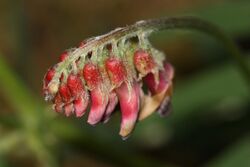Biology:Vicia nigricans
| Vicia nigricans | |
|---|---|

| |
| ssp. gigantea | |
| Scientific classification | |
| Kingdom: | Plantae |
| Clade: | Tracheophytes |
| Clade: | Angiosperms |
| Clade: | Eudicots |
| Clade: | Rosids |
| Order: | Fabales |
| Family: | Fabaceae |
| Subfamily: | Faboideae |
| Tribe: | Fabeae |
| Genus: | Vicia |
| Species: | V. nigricans
|
| Binomial name | |
| Vicia nigricans Hook. & Arn.
| |
| Synonyms | |
|
Vicia gigantea Hook. (non Bunge) | |
Vicia nigricans is a species of vetch known by the common name black vetch. It has a disjunct distribution, its two subspecies divided by thousands of miles in range. The northern subspecies, ssp. gigantea (giant vetch), is native to western North America from Alaska to northern California , where it occurs in coastal and moist inland habitat and disturbed areas. The southern subspecies, ssp. nigricans, occurs in southern South America, in Argentina and Chile .[1]
This vetch is a perennial herb with stout, hollow, and ridged climbing stems that may reach two meters in length. It attaches to objects and other plants by its large branched tendrils for support.[2] The leaves are made up of 9 to 13 pairs of lance-shaped or elongated oval leaflets that may measure up to 4 centimeters in length.[2] The inflorescence is a one-sided raceme of up to 15 or 20 flowers which have pale pink to dark reddish purple or sometimes yellowish to orange corollas. The flowers, each with a calyx about half as long as the corolla, are 1 to 2 centimeters long. They yield fruits which are legume pods measuring up to 4 centimeters long by 1.5 wide. As they dry they turn black.
References
- ↑ {{citation | mode = cs1 | title = Vicia nigricans subsp. nigricans | work = Germplasm Resources Information Network (GRIN) | url = https://npgsweb.ars-grin.gov/gringlobal/taxonomydetail.aspx?313972 | publisher = [[Organization:Agricultural Research ServAgricultural Research Service (ARS), United States Department of Agriculture (USDA) | access-date = 23 January 2018 }}
- ↑ 2.0 2.1 Pojar, Jim; Andy MacKinnon (2004). Plants Of The Pacific Northwest Coast: Washington, Oregon, British Columbia & Alaska. Lone Pine Publishing. p. 193. ISBN 978-1-55105-530-5. https://archive.org/details/plantspacificnor00poja.
External links
Wikidata ☰ Q4115589 entry
 |

